John Brown's Fort
John Brown's Fort was originally constructed in 1848 for use as a guard and fire engine house by the federal Harpers Ferry Armory in Harpers Ferry, West Virginia, then a part of Virginia.
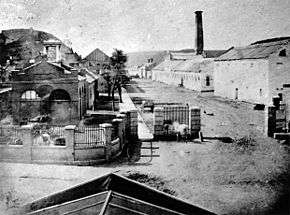
An 1848 military report described the building as "An engine and guard-house 35 1/2 x 24 feet, one story brick, covered with slate, and having copper gutters and down spouts…"[1] The building achieved notoriety during John Brown's Raid on the Harpers Ferry Armory in 1859.
John Brown's raid
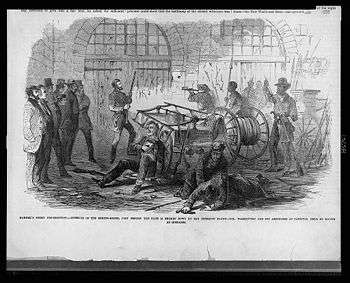
John Brown planned to capture the armory and the associated arsenal and use them to supply an army of abolitionists and run-away slave guerrillas. Beginning their raid the night of October 16, Brown and his small army of 21 men (16 white and 5 black) captured the armory and arsenal and succeeded in taking 60 citizens of Harper's Ferry hostage. The local militia and armed townspeople killed several members of the insurrection and forced Brown to take up position in the fire engine house where Brown's men had placed several of the hostages and prepared a defensive fortification. On the night of October 17, U.S. marines and then Brevet Colonel Robert E. Lee and his aide J.E.B. Stuart arrived in Harper's Ferry to put down Brown's insurrection. The next morning, using a ladder as a battering ram, the marines battered down the door and stormed the fire engine house. One marine was mortally wounded in the attack as well as several of Brown's men. Some of Brown's men managed to escape, but most were captured, including Brown who was stabbed by the Marine commander, Lt. Green. The hostages were freed.
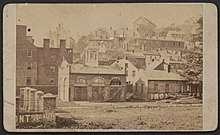
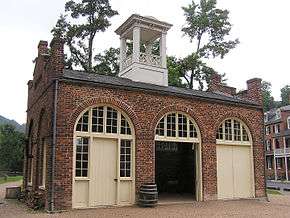
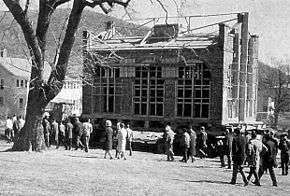
After the raid
After Brown's raid, the fire engine house became known as "John Brown's Fort", and "was a tourist destination—almost a shrine—for African Americans in the late nineteenth century."[2] In 1891, the building was sold to a buyer who wished to use it as an attraction close to the World's Columbian Exposition in Chicago. The building only had 11 visitors and was dismantled and left on a vacant lot after the exhibition. In 1894, a movement was spearheaded by Washington D.C. journalist Kate Field to preserve the building and move it back to Harper's Ferry.[1] Alexander and Mary Murphy deeded 5 acres (20,000 m2) of their Harpers Ferry farm for one dollar as a relocation site, and the Baltimore and Ohio Railroad provided free shipping. Reconstruction of John Brown's Fort on the Murphy farm was completed by November 1895, which included the gates that surrounded the fort. The Murphy Farm was originally established September 1, 1869, and the National Park Service purchased the farm through the Trust for Public Land on December 31, 2002.
On August 17, 1906, at the Murphy Farm members of the Niagara Movement held an onsite memorial for Brown they called "John Brown Day". Over one hundred prominent African-American men and women walked past the farmhouse to the Fort's location, among them W.E.B. DuBois, Lewis Douglas, and W. T. Greener. The leader of the procession, a physician from Brooklyn named Owen Waller, removed his shoes and socks as if he were walking on holy ground.[3]
In 1909, Storer College in Harper's Ferry bought John Brown's Fort from Alexander Murphy for $900 and moved it to the college's campus. In 1960, the National Park Service acquired the building and, in 1968, moved it once more to a location close to its original site, which had been covered by a railroad embankment in 1894. The Fort is now part of the Harpers Ferry National Historical Park run by the NPS and sits 150 feet from its original location.[4] 39°19′22.95″N 77°43′46.43″W
The structure cannot be considered "fully authentic" due to the number of times it has been dismantled, moved, and reassembled, each time with potential loss of original building material. It is also not an exact replica, as portions of the building were reconstructed backwards.[5]
The John Brown Museum now houses the original armory gate as well as Alexander Murphy's picture. The original armory gate was donated to the NPS by Jim Kuhn, great-great-grandson, for no money or tax benefit; the remaining gates were donated in 1997.
Controversy over bell
During a Union Army occupation of Harpers Ferry, a contingent of soldiers from Marlborough, Massachusetts, removed a bell hanging in the Harpers Ferry arsenal firehouse, which had served as John Brown's Fort. Several of those from Marlborough were in the local fire department, called the "'Torrent' Fire/Engine Company", according to the city of Marlborough website. They took the bell back to Marlborough, where it has remained. Harpers Ferry has attempted to retrieve the bell without success.[6]
In July 2011, Howard Swint of Charleston, West Virginia threatened to sue the city of Marlborough in an attempt to obtain the bell for Harpers Ferry. He has drafted, but not filed his lawsuit (as of July 20, 2011).[7] However, his action has generated controversy in the Marlborough area.[8][9][10][11] Swint's research findings were published in a Massachusetts newspaper editorial column.[12]
Replica at Discovery Park of America
An approximate replica of the firehouse was built in 2012 at the Discovery Park of America museum park in Union City, Tennessee. There is a marker explaining the link with John Brown's raid.[13][14][15]
References
- "Harpers Ferry National Historical Park - John Brown's Fort". www.nps.gov. National Park Service. Retrieved September 15, 2016.
- Brophy, Alfred L. (April 2008). "The Creation of Harpers Ferry". h-Net (h-Civil War). Retrieved December 15, 2018.
- Quarles, Benjamin (2001). Allies for Freedom & Blacks on John Brown. Da Capo Press. pp. 4–14.
[page 4] Defying stone and stubble, Waller took off his shoes and socks and walked barefoot as if he were treading on holy ground.
- "John Brown's Fort". Harpers Ferry National Historical Park, National Park Service. Retrieved 6 March 2010.
- Moyer, Teresa S. and Paul A. Shackel. The Making of Harpers Ferry National Historical Park: A Devil, Two Rivers, and a Dream; Rowman Altamira, 2008, p. 92
- Joan Abshire (March 12, 2008). "The John Brown Bell" (PDF).
- Howard Swint (n.d.). "IN THE UNITED STATES DISTRICT COURT — NORTHERN DISTRICT OF WEST VIRGINIA". Archived from the original on 2012-11-11.
- Kendall Hatch (July 20, 2011). "Battle resumes over Marlborough's John Brown bell".
- Paul Brodeur (July 24, 2011). "Battle of the John Brown bell".
- Metrowest Daily News (July 25, 2011). "Editorial: Give back the bell".
- Paul Brodeur (July 29, 2011). "Legal reality behind Brown's Bell". Archived from the original on December 14, 2013.
- Howard Swint (August 3, 2011). "Howard Swint:Who Owns John Browns Bell?". The MetroWest Daily News. Retrieved August 20, 2016.
- "Fire Station House at Discovery Park Of America". Dreamstime. 2013. Retrieved November 15, 2018.
- Caudle, Glenda (March 29, 2013). "DPA firehouse based on historical building" (PDF). Union City Daily Messenger.
- Hughes, Sandra (2017). "The Firehouse". Historical Markers Database.